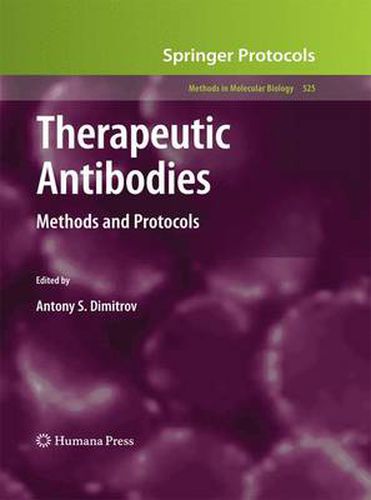Readings Newsletter
Become a Readings Member to make your shopping experience even easier.
Sign in or sign up for free!
You’re not far away from qualifying for FREE standard shipping within Australia
You’ve qualified for FREE standard shipping within Australia
The cart is loading…






Over 2000 years ago in China, antibodies elicited by early forms of vaccination likely played a major role in the protection of the population from infectious agents. Vac- nation has been further developed in Europe and described by Edward Jenner in the late-eighteenth century, then successfully implemented worldwide. The idea to use theactiveingredientinthebloodofvaccinated(orimmunized)animalsorhumansfor the treatment of diseases came a century later. It was made possible by a series of discoveries,suchastherealizationthattheserumfromanimalsimmunizedwithtoxins, for example, diphtheria toxin or viruses, is an effective therapeutic against the disease causedbythesameagentinhumans. Inthe1880s,vonBehringdevelopedanantitoxin (anti-body) that did not kill the bacteria but neutralized the bacterial toxin. The first Nobel Prize in Medicine (1901) was given to him for the discovery of the serum therapy. Acenturylater,22monoclonalantibodies(mAbs)areapprovedbytheUnited States Food and Drug Administration (FDA) for clinical use, and hundreds are in clinicaltrialsforthetreatmentofvariousdiseasesincludingcancers,immunedisorders, and infections. The revenues from the top-five therapeutic antibodies reached $11. 7 billion in 2006, and major pharmaceutical companies raced to acquire antibody biotech companies with a recent example of MedImmune, Inc. , which was acquired for $15. 6 billion by AstraZeneca in 2007. This explosion of research and development in the field of therapeutic antibodies prompted the publication of the MiMB volume Therapeutic Antibodies: Methods and Protocols. The book’s major goal is to present a set of protocols useful for researchers discoveringanddevelopingtherapeuticantibodies. Currentadvancesandfuturetrends in the antibody therapeutics are analyzed in the lead-in review article.
$9.00 standard shipping within Australia
FREE standard shipping within Australia for orders over $100.00
Express & International shipping calculated at checkout
Over 2000 years ago in China, antibodies elicited by early forms of vaccination likely played a major role in the protection of the population from infectious agents. Vac- nation has been further developed in Europe and described by Edward Jenner in the late-eighteenth century, then successfully implemented worldwide. The idea to use theactiveingredientinthebloodofvaccinated(orimmunized)animalsorhumansfor the treatment of diseases came a century later. It was made possible by a series of discoveries,suchastherealizationthattheserumfromanimalsimmunizedwithtoxins, for example, diphtheria toxin or viruses, is an effective therapeutic against the disease causedbythesameagentinhumans. Inthe1880s,vonBehringdevelopedanantitoxin (anti-body) that did not kill the bacteria but neutralized the bacterial toxin. The first Nobel Prize in Medicine (1901) was given to him for the discovery of the serum therapy. Acenturylater,22monoclonalantibodies(mAbs)areapprovedbytheUnited States Food and Drug Administration (FDA) for clinical use, and hundreds are in clinicaltrialsforthetreatmentofvariousdiseasesincludingcancers,immunedisorders, and infections. The revenues from the top-five therapeutic antibodies reached $11. 7 billion in 2006, and major pharmaceutical companies raced to acquire antibody biotech companies with a recent example of MedImmune, Inc. , which was acquired for $15. 6 billion by AstraZeneca in 2007. This explosion of research and development in the field of therapeutic antibodies prompted the publication of the MiMB volume Therapeutic Antibodies: Methods and Protocols. The book’s major goal is to present a set of protocols useful for researchers discoveringanddevelopingtherapeuticantibodies. Currentadvancesandfuturetrends in the antibody therapeutics are analyzed in the lead-in review article.